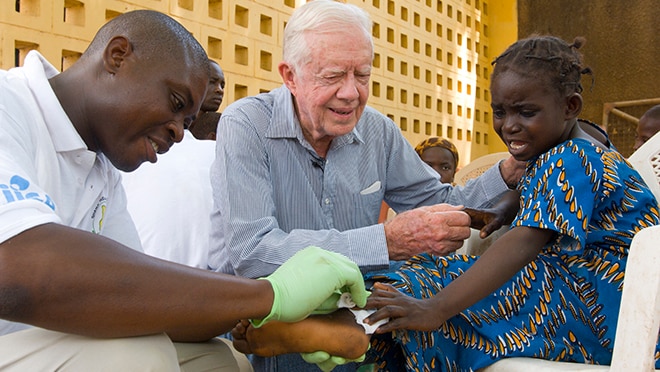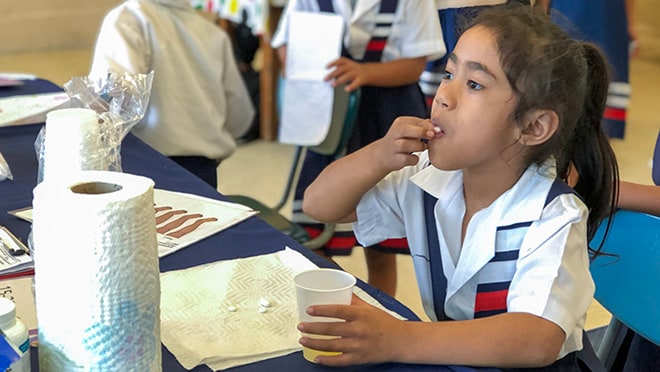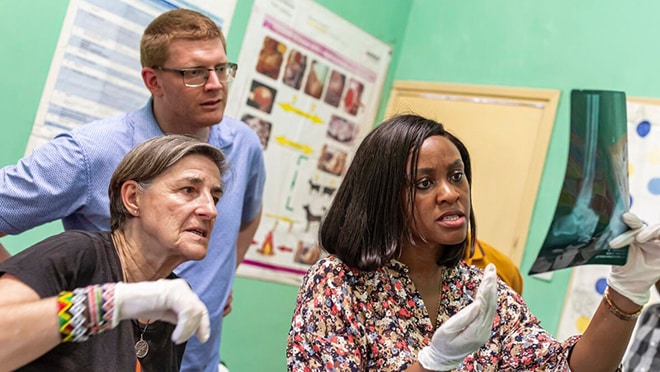At a glance
- Global neglected tropical disease (NTD) programs focus on identifying regions and countries where NTDs are present and working to control or, when possible, eliminate them.
- CDC works within countries and through regional collaborations to help improve existing NTD interventions, such as mass drug administration (MDA) campaigns.

President Jimmy Carter's Lasting Impact
Creating Pathways to Control and Eradicate Neglected Tropical Diseases
CDC shares its heartfelt condolences to the family, friends, and colleagues of former United States President Jimmy Carter. In addition to his many years of public service, President Carter, along his wife, Rosalynn, founded The Carter Center in 1982. Its purpose was and remains to "wage peace, fight disease, and build hope in communities worldwide."
To support the fight against disease, The Carter Center joined forces with CDC and other global partners to establish the Guinea Worm Eradication Program in 1986. At the time, there were an estimated 3.5 million cases of Guinea worm disease in 20 countries. Due to the commitment from partners, The Carter Center, and President Carter himself, cases of Guinea worm disease have decreased by 99.99 percent, making it likely to be the first human disease eradicated since smallpox. This will be an astounding feat considering there are no drugs to treat nor vaccines to prevent Guinea worm disease.

President Carter famously said, in his 2002 Nobel Peace Prize acceptance speech, "Most of The Carter Center's [work] is in remote villages in the poorest nations in Africa and there I have witnessed the capacity of destitute people to persevere under heartbreaking conditions. I have come to admire their judgment and wisdom, their courage and faith in their awesome accomplishments when given a chance to use their innate abilities."
CDC salutes President Carter for pioneering new public health approaches to preventing and controlling devasting neglected tropical diseases including Guinea worm disease, lymphatic filariasis, river blindness, schistosomiasis, and trachoma.* And CDC aims to carry out his vision by eradicating Guinea worm disease by 2030.
*The Carter Center also works on malaria and lymphatic filariasis through its Hispañola Initiative and on mental health programs, a cause championed by Rosalynn Carter.
Guinea worm eradication program
The global campaign to eradicate Guinea worm disease began in 1980 at CDC.
At that time, 20 countries, mainly in Africa, had approximately 3.5 million human cases of Guinea worm disease each year. In 1986, the World Health Assembly adopted a resolution calling for the eradication of GWD. The global Guinea Worm Eradication Program, led by The Carter Center working with health ministries, CDC, and other global partners, has helped build local, national, and international partnerships that have proven enormously effective. Today, fewer than 100 human cases occur annually in a handful of African countries, although cases in animals, primarily domestic dogs now outnumber human cases.
Lymphatic filariasis: global elimination efforts
The World Health Organization’s Global Programme to Eliminate Lymphatic Filariasis (GPELF) was launched in 2000. GPELF aims to stop transmission and alleviate the suffering of those already affected by the disease. In areas with a high number of individuals at risk, anti-parasitic drugs are given to the entire population once a year for at least five years to stop the spread of infection. Health education efforts is provided lessen the severity and number of leg infections in people already infected who have swollen legs. Expanding the availability of surgery for men with hydrocele due to lymphatic filariasis is also an aim of the program. The goal set by the most recent WHO road map is to eliminate lymphatic filariasis as a public health problem in at least 58 countries by 2030.

Onchocerciasis: global elimination efforts
Onchocerciasis, also known as "river blindness", is a major cause of blindness and skin disease in Africa and the Americas. For many years, endemic areas have sought to control onchocerciasis using vector control and community mass distribution with the antiparasitic drug ivermectin. Country-wide elimination of transmission has been verified in four countries: Colombia (2013), Ecuador (2014), Mexico (2015) and Guatemala (2016). Local interruption of transmission has been demonstrated in multiple countries in Africa and the Americas. The Onchocerciasis Elimination Program for the Americas (OEPA), a regional initiative launched in 1992, has supported onchocerciasis elimination through a partnership with the six endemic countries in the region, Pan American Health Organization (PAHO), CDC, and other partners. In Africa, there have been three WHO programs that have supported countries to develop and implement strategies: the Onchocerciasis Control Programme (OCP (1973 – 2002), the African Programme for Onchocerciasis Control (APOC) (1995 – 2015) and the Expanded Special Project for the Elimination of Neglected Tropical Diseases in Africa (ESPEN) (2016 – present). These programs have been able to reach more than 150 million people to markedly reduce blindness and skin disease. Treatment has been able to be stopped for nearly 8 million people who are now longer at risk for onchocerciasis. The most recent WHO road map sets a goal of achieving country-level verification of onchocerciasis elimination in at least 12 countries in Africa by 2030.
Related Links
Schistosomiasis: global control efforts
The burden of schistosomiasis in affected communities is measured by identifying areas where many school-aged children infected. Depending on disease prevalence, the drug praziquantel is provided to school-aged children or to the entire community usually as a yearly dose. The medicine kills adult parasites and reduces the severity of the disease.
Mycetoma, chromoblastomycosis, and sporotrichosis: global control efforts
Mycetoma, chromoblastomycosis, and sporotrichosis are fungal neglected tropical diseases (NTDs) and cause substantial disability and stigma in the Americas, Africa, and Asia. Unlike some NTDs, fungal NTDs cannot be eliminated because the fungi that cause them live in the soil, on plant matter, and in the environment.
CDC partners with the World Health Organization and regional experts to organize and lead global working groups focusing on mycetoma, chromoblastomycosis, and sporotrichosis. Along with experts and researchers, these working groups also comprise of healthcare providers and public health officials, including those who work with affected populations.

Efforts to improve the global public health response to fungal NTDs include conducting collaborative surveillance, applying new technologies to improve diagnostics and strengthening diagnostic capacity, and increasing access to affordable, effective treatment. Through quality-of-life studies, the workgroups are estimating the true burden of each of these diseases. These groups develop and disseminate best practices and scientific evidence to reduce the impact of fungal NTDs worldwide. Activities of the working groups align with the World Health Organization's NTD Road Map.
Trachoma: global elimination efforts
Trachoma is a bacterial infection of the eye, spread from person-to-person by direct contact. Untreated infection causes scarring of the upper eyelid that can lead to blindness; trachoma is the world’s leading infectious cause of blindness. Treatment for trachoma is focused on treating the symptoms and helping to prevent future infection. A major comprehensive public health strategy approved by the World Health Organization, called SAFE, is underway to treat trachoma epidemics in rural Africa and other parts of the developing world. The combination of surgery (S), antibiotics (A), facial cleanliness (F) and environmental improvements (E) is a multi-pronged approach to the disease and has shown promising results. A highly effective and safe antibiotic called Zithromax is being utilized to assist in trachoma control.
United States government initiatives to address NTDs
USAID NTD Program
Since 2006, the United States Agency for International Development (USAID) has supported 33 developing countries in their efforts to control and eliminate five of the most prevalent NTDs – lymphatic filariasis (LF), trachoma, onchocerciasis, schistosomiasis, and soil transmitted helminths (hookworm, roundworm, and whipworm).
USAID works alongside developing country governments and public- and private-sector partners to map where disease persists, treat at-risk populations, evaluate progress, and build a sustainable in-country response. A hallmark of USAID's NTD Program is the generous donation of billions of dollars in treatments from pharmaceutical partners. Considered a "best buy" in global health, every $1 invested in NTDs by the U.S. government leverages $26 in donated treatments. As a result of USAID's investment, hundreds of millions of people live in communities no longer at risk for these diseases.
USAID and CDC work together on a shared agenda to advance global progress towards the control and elimination of NTDs that can be addressed with preventive chemotherapy (such as lymphatic filariasis, onchocerciasis, schistosomiasis, soil transmitted helminths and trachoma). CDC conducts scientific and operational research critical to defining NTD normative guidance for programming, developing disease specific monitoring and evaluation frameworks, and strengthening diagnostics and laboratory tools. CDC has strong working relationships with WHO, regional reference laboratories/bodies, national NTD programs, researchers, and collaborating centers, working with these partners through the provision of unique laboratory, diagnostic, and epidemiological technical assistance to advance programs and operational research.
